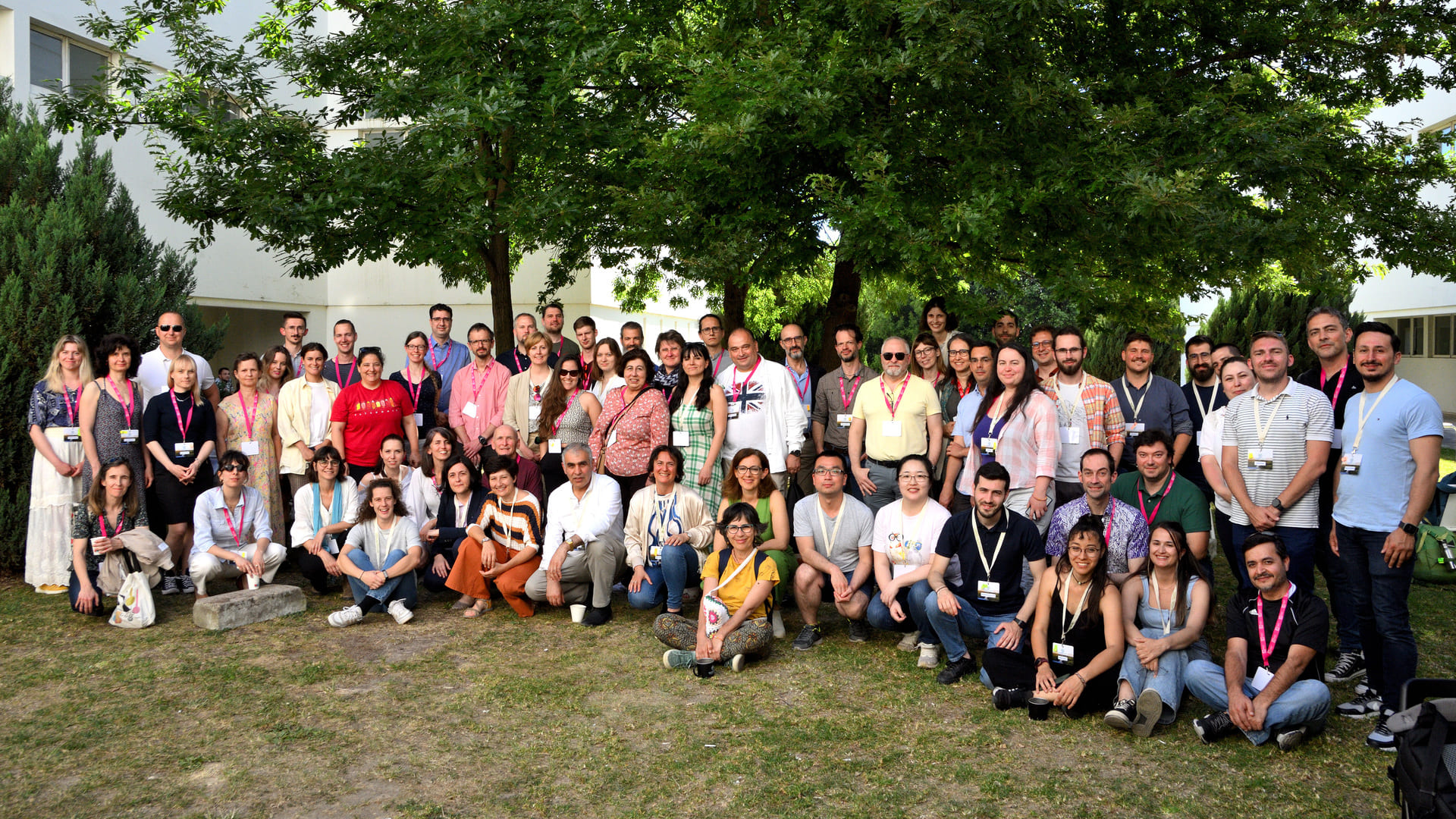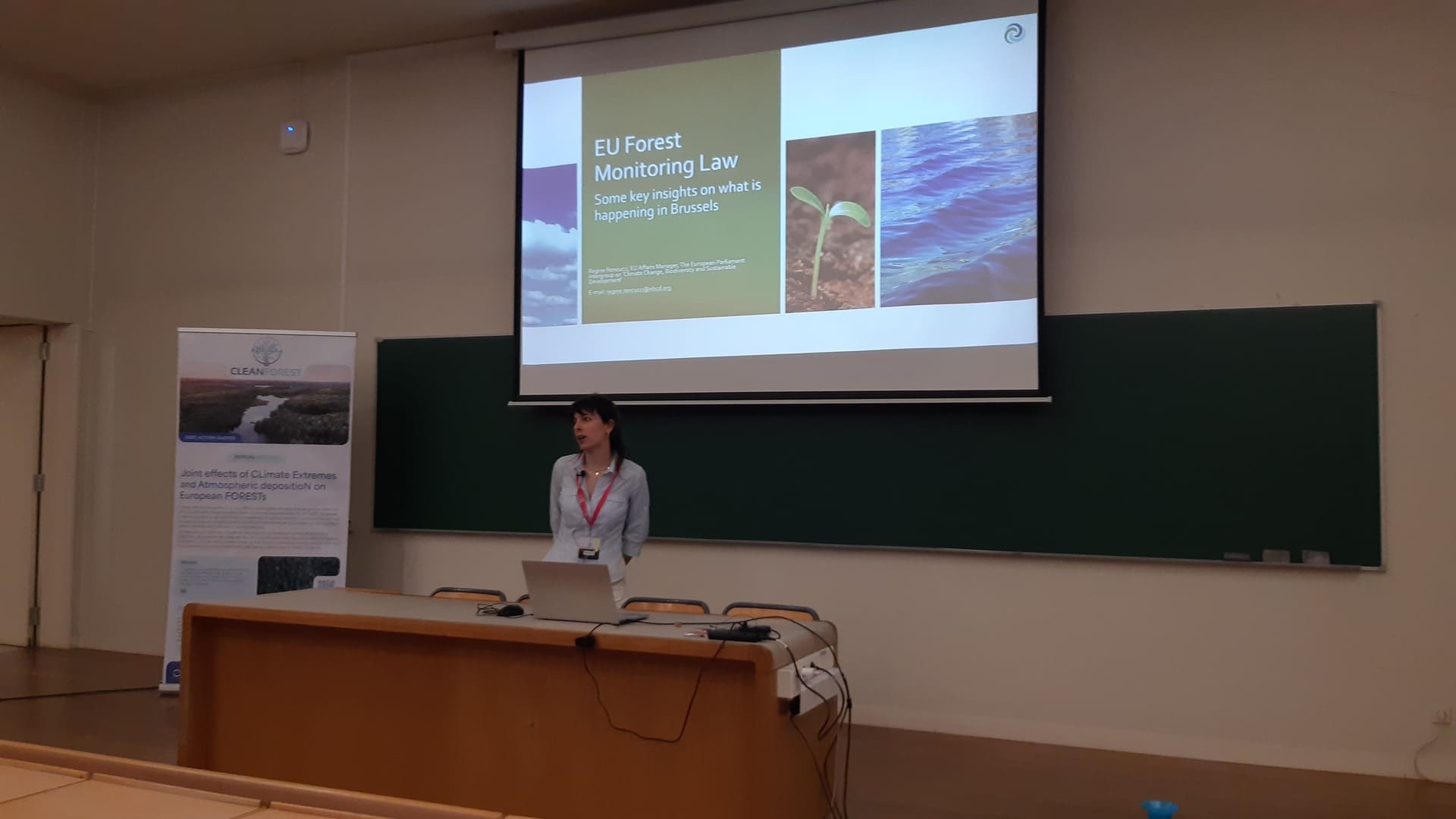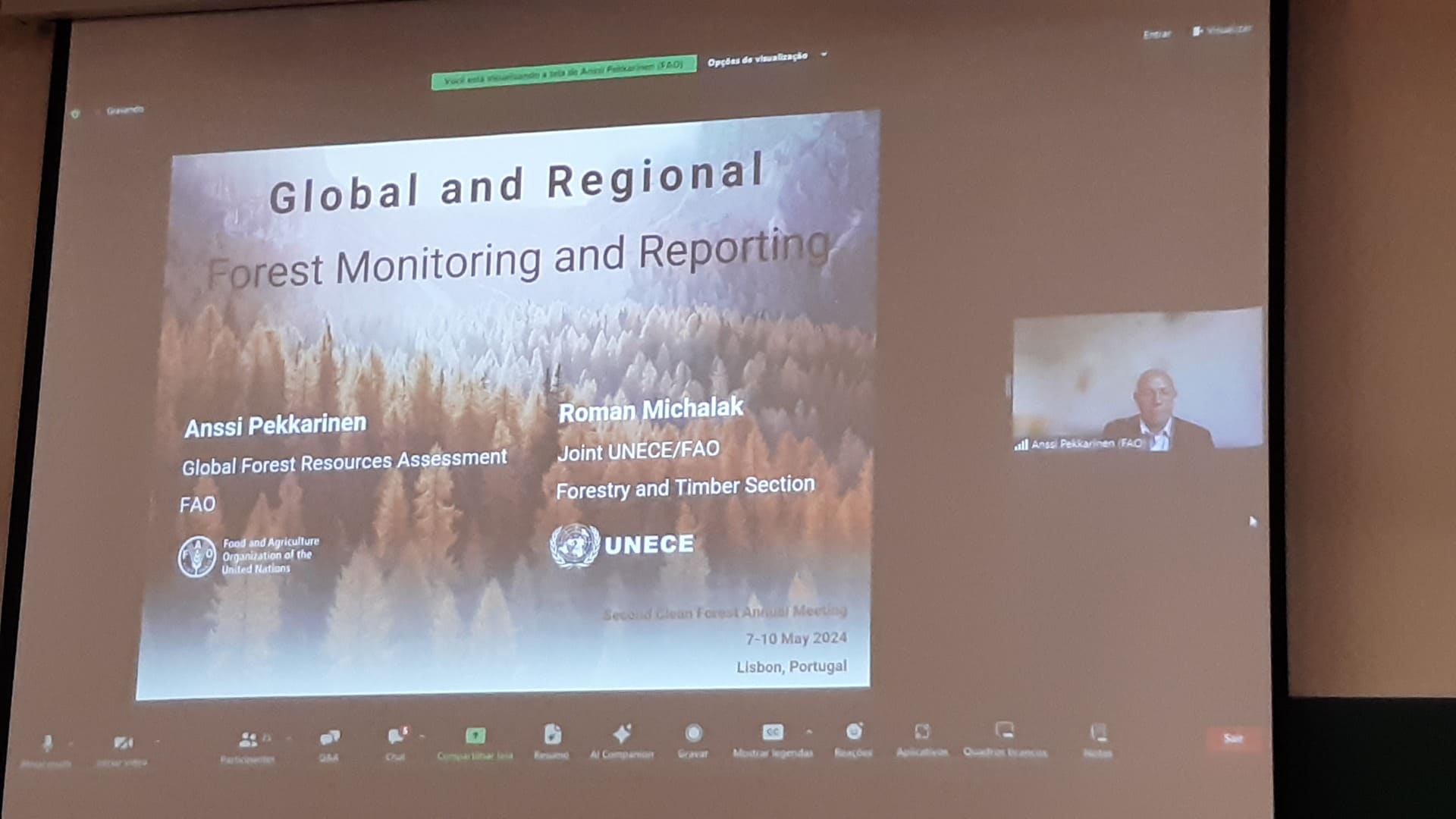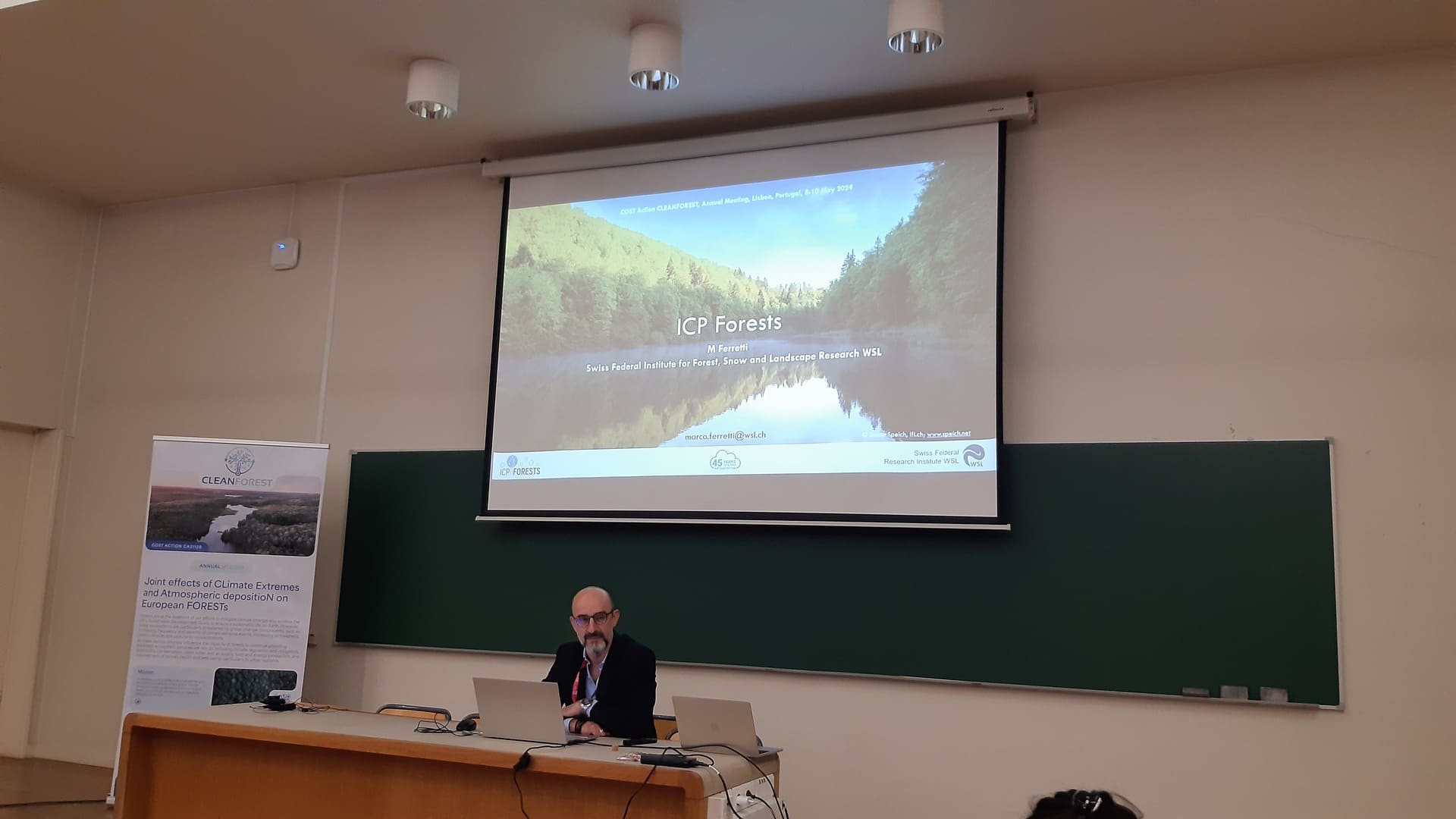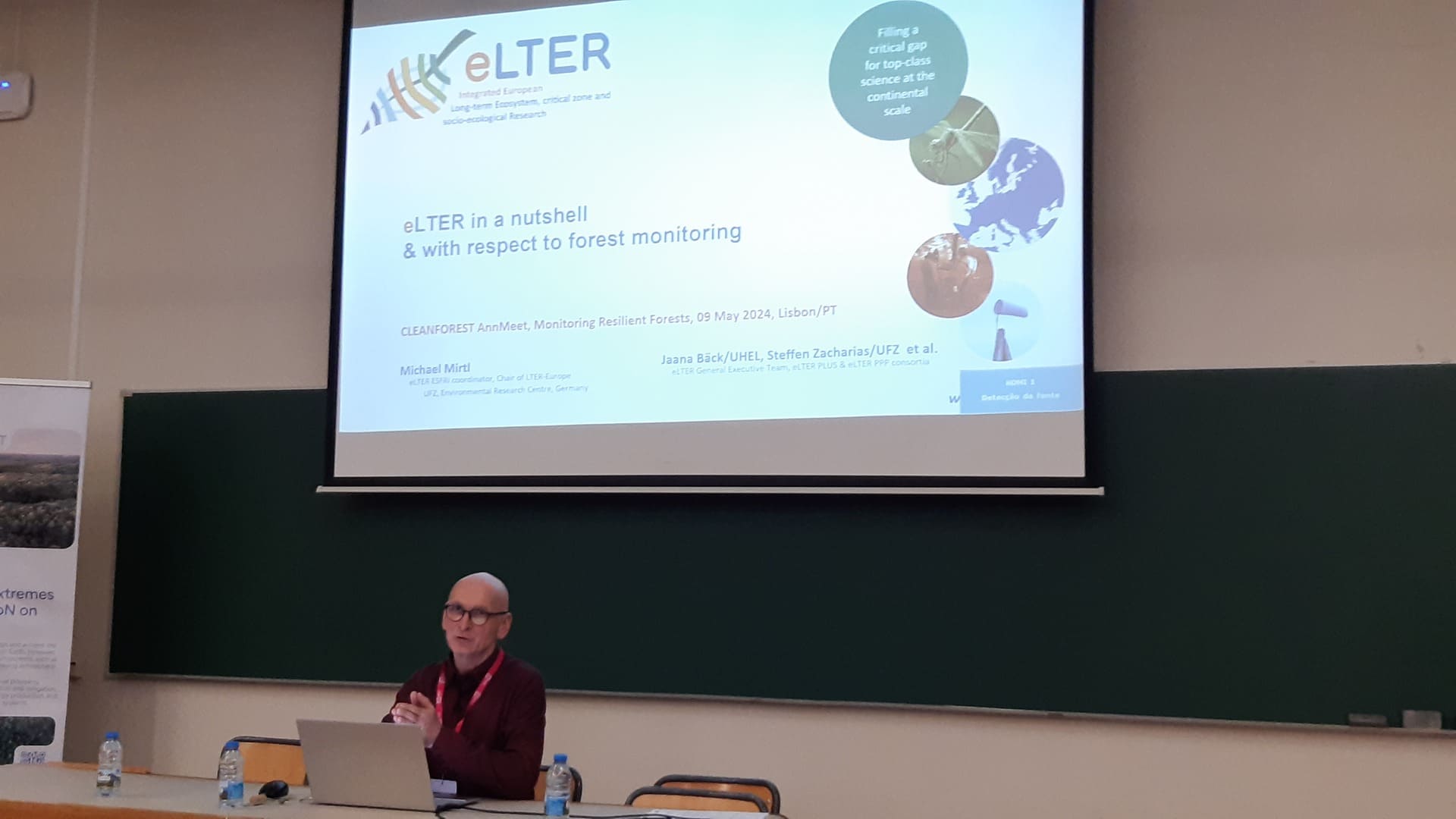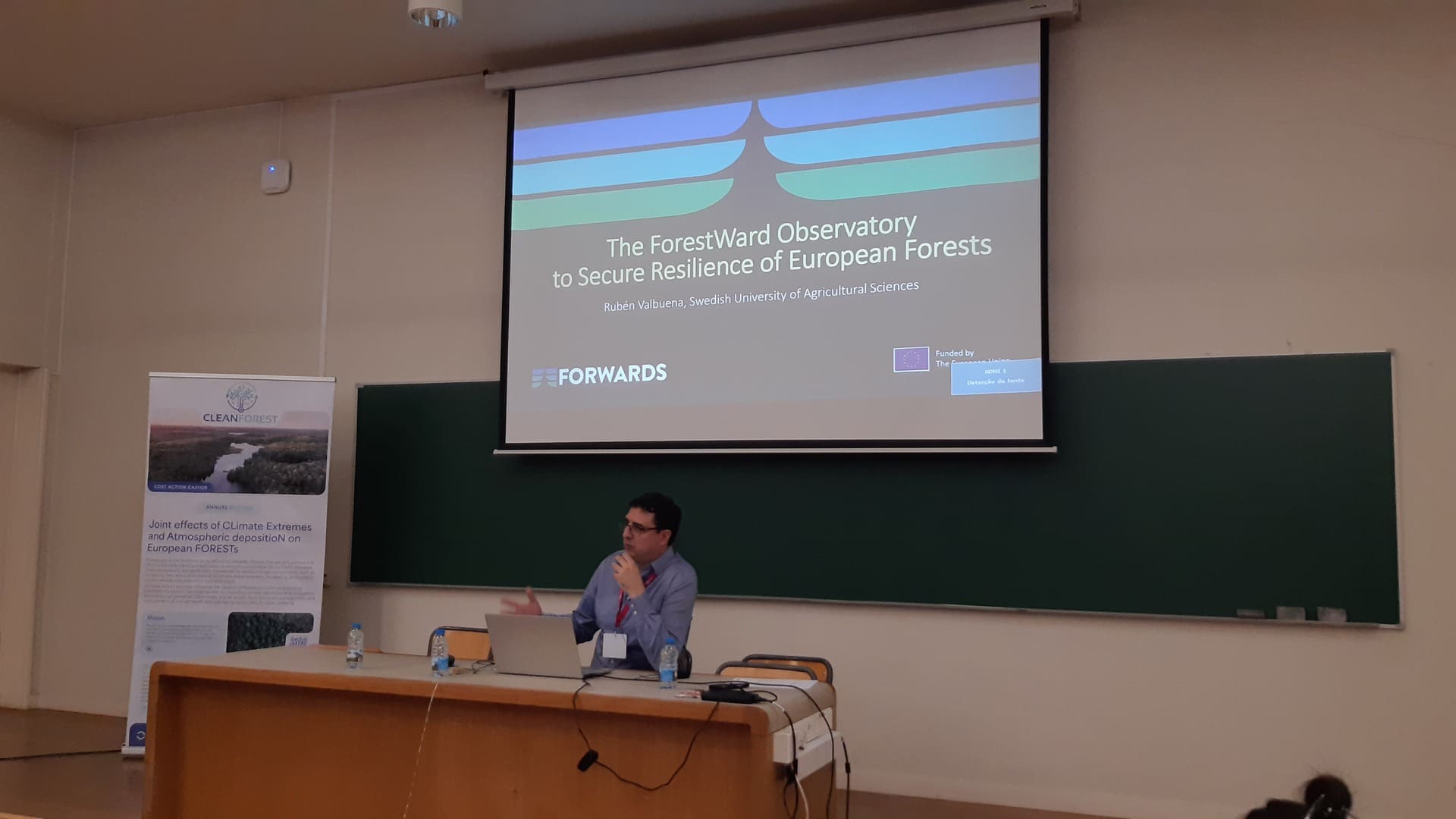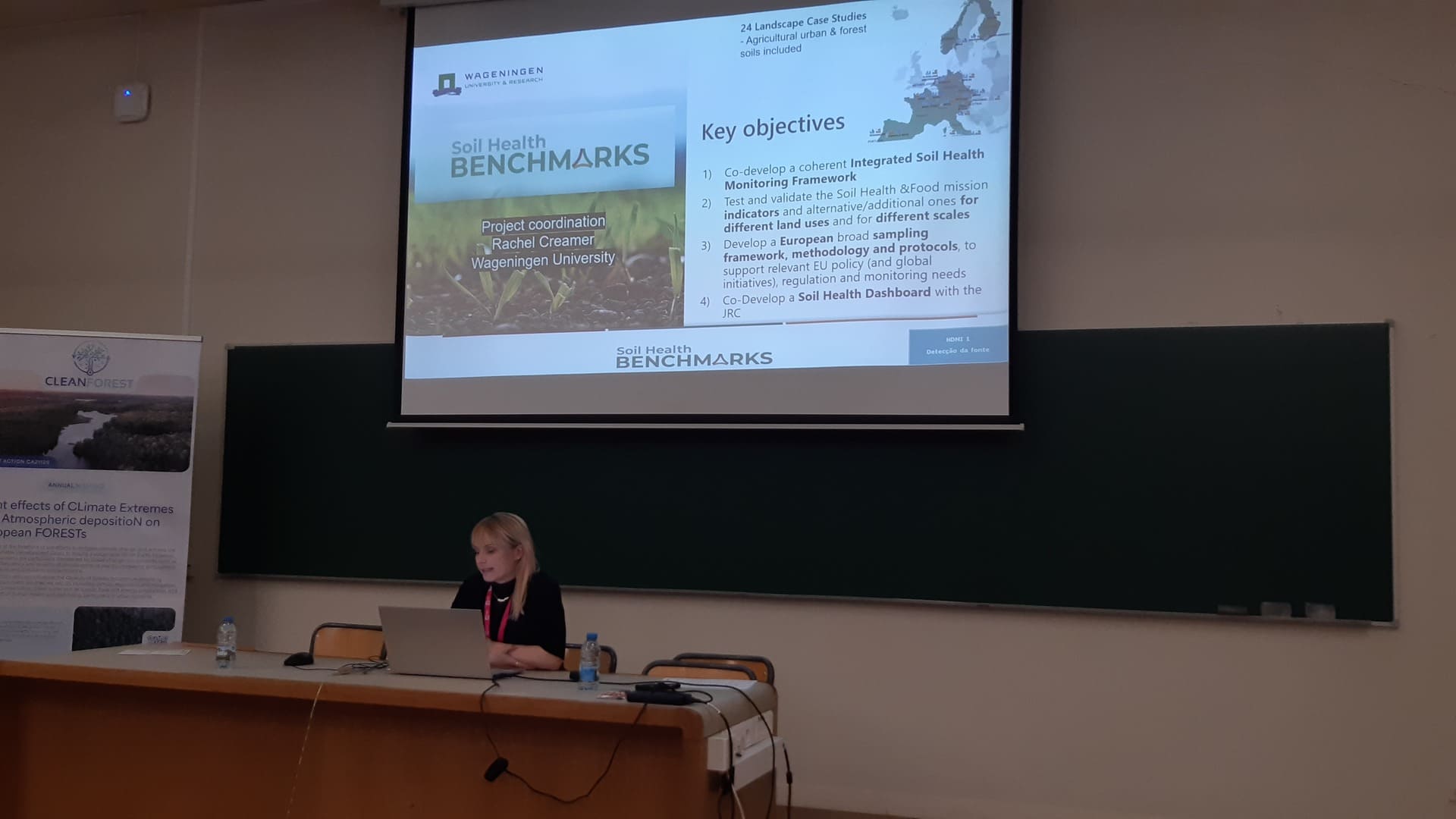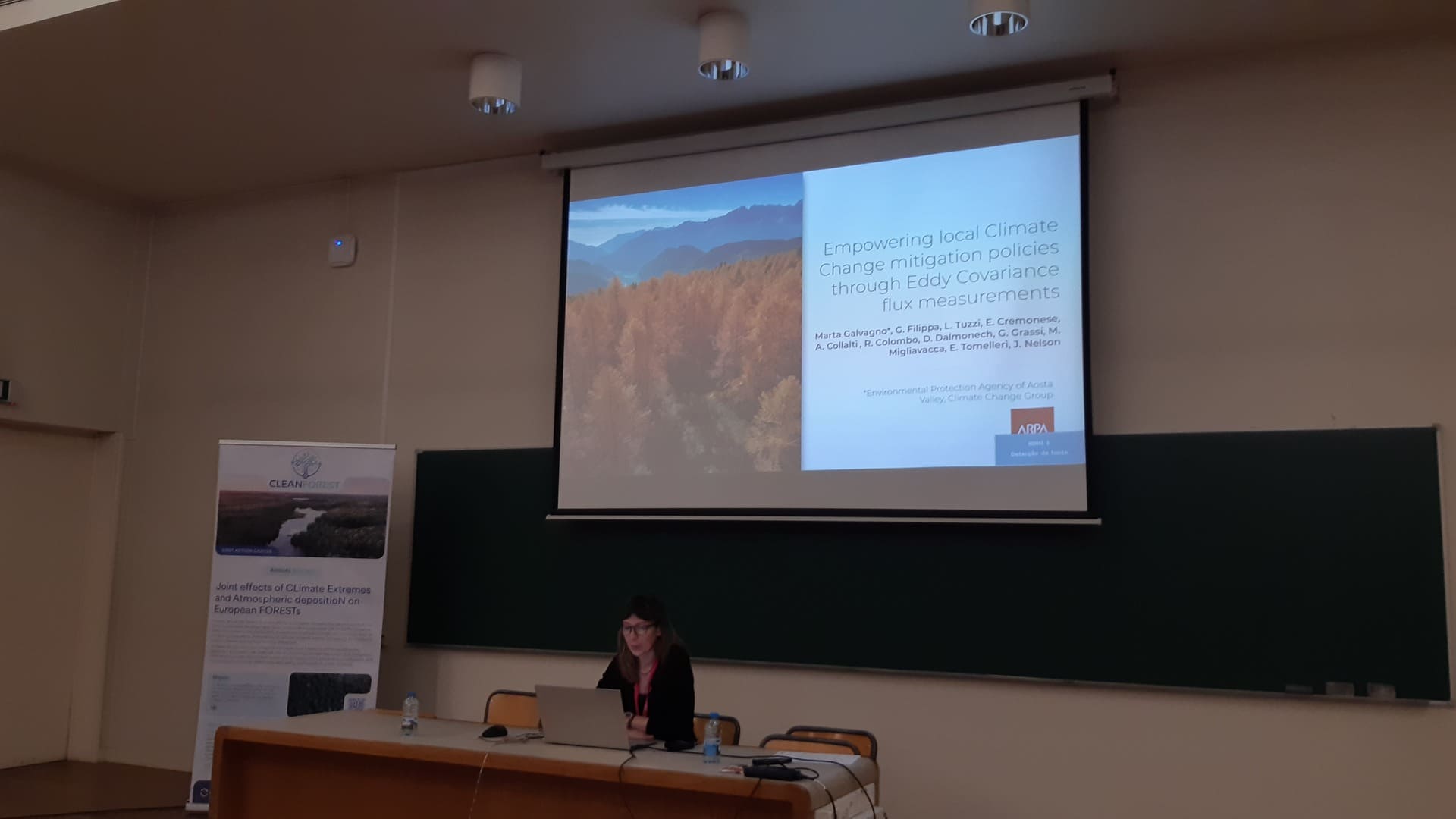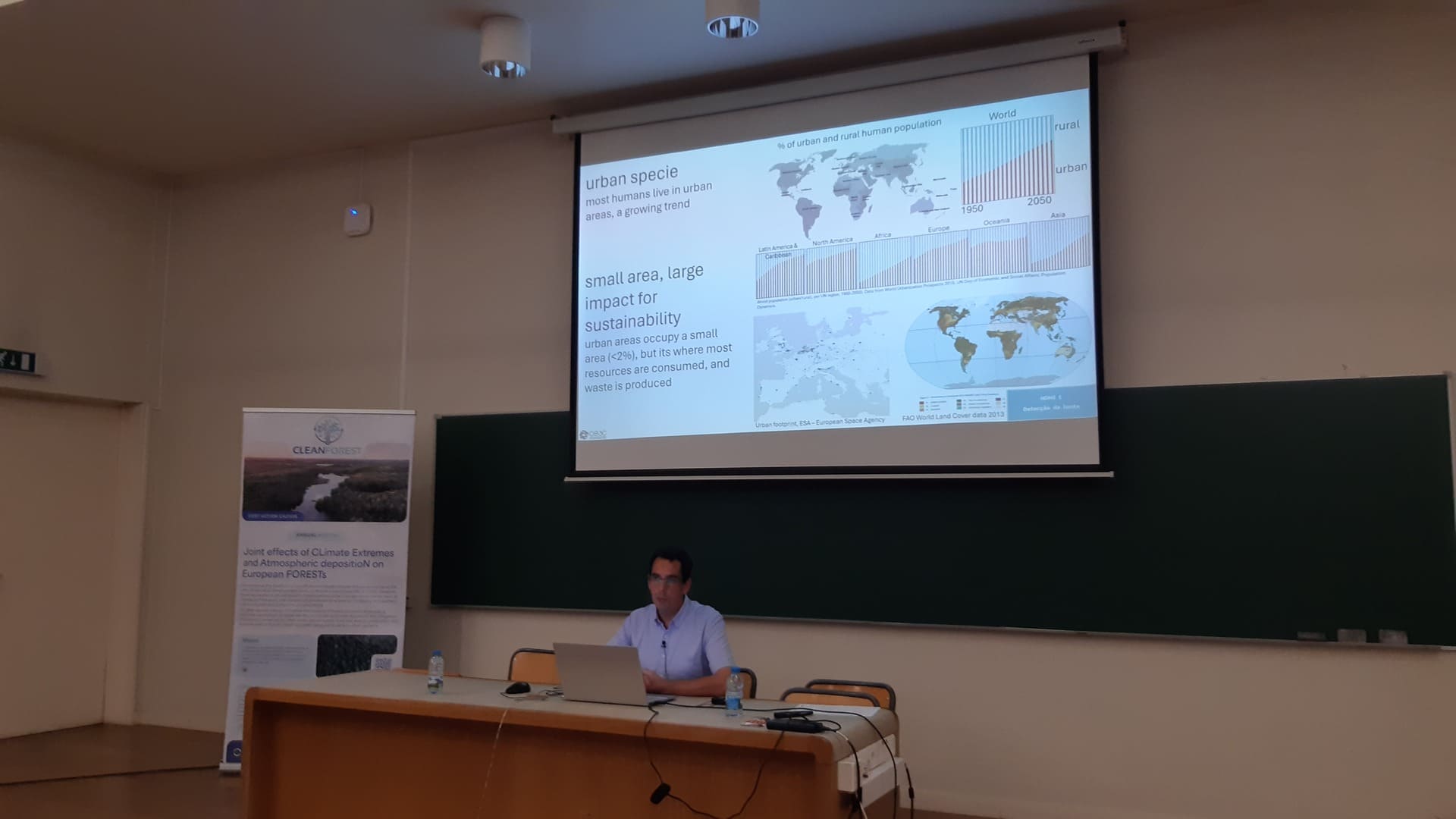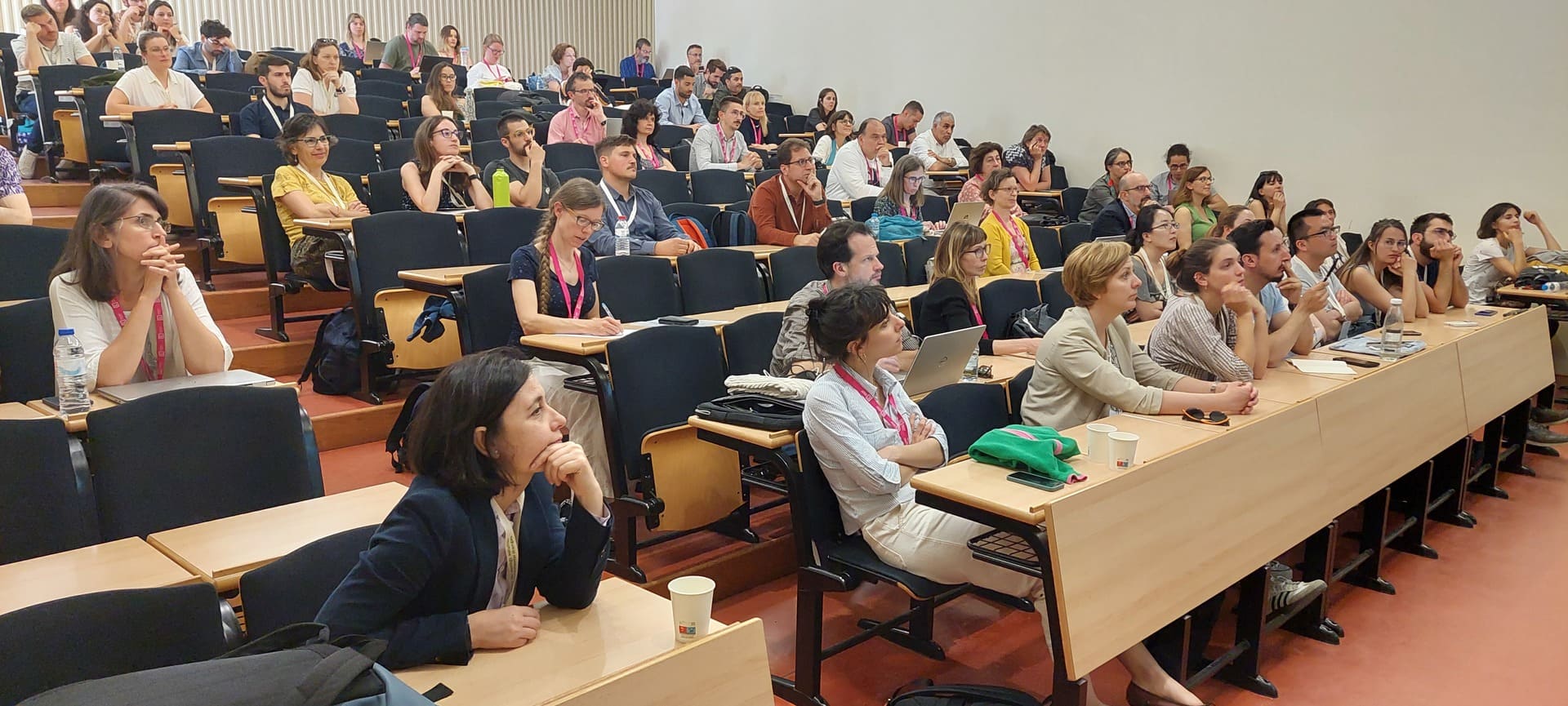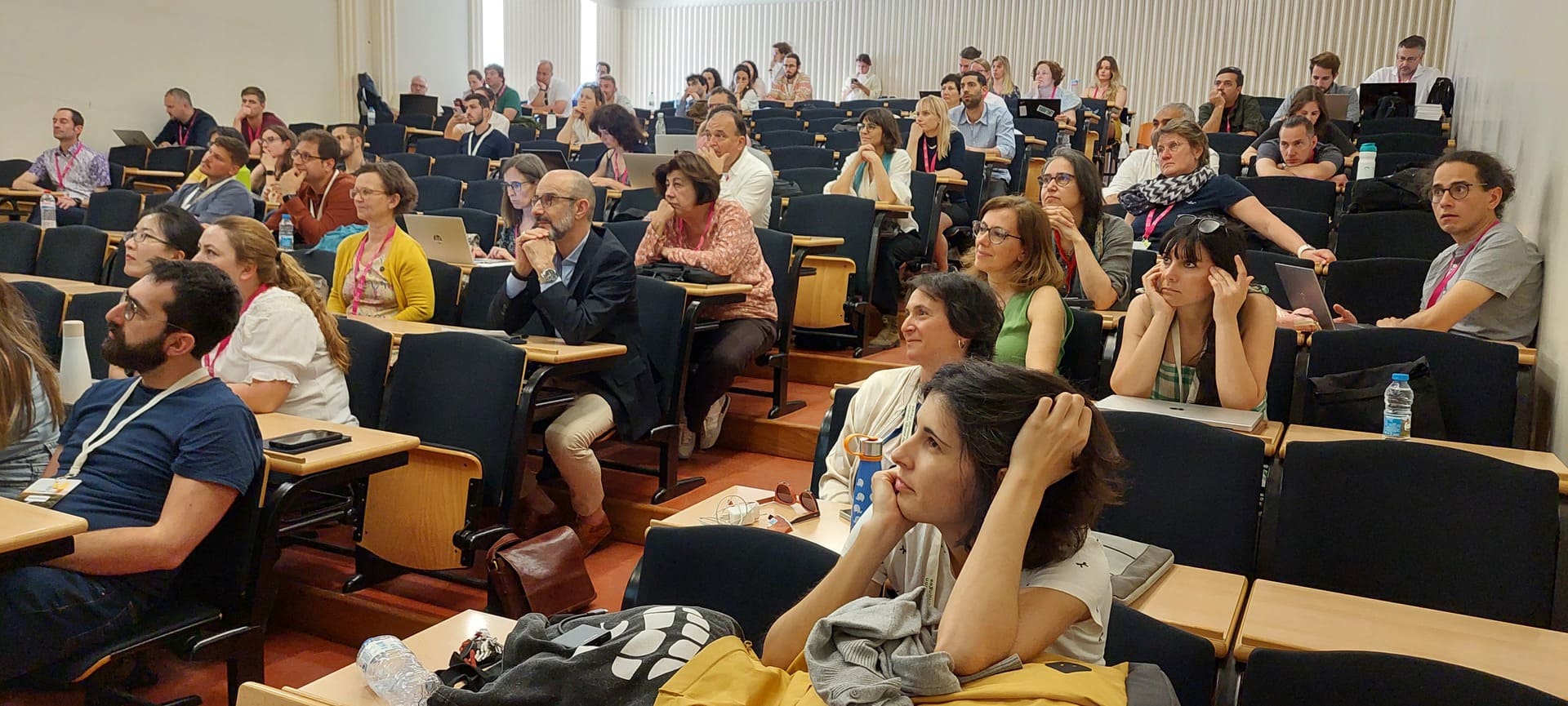Second CLEANFOREST Annual Meeting
7.-10.5.2024, Lisbon, Portugal
Workshop: Monitoring for Resilient Forests – Needs, Gaps, and Way Ahead
The third day of the CLEANFOREST Annual Meeting was dedicated to the workshop on „Monitoring for Resilient Forests – Needs, Gaps, and Way Ahead“. The Plenary sessions in the morning, which were well attended by on-site and virtual participants, were followed by lively and creative breakout sessions in the afternoon.
Plenary session Forest monitoring: global assessment and policy perspectives | |
|---|---|
09:10 – 09:30 | Regine Roncucci (EU Affairs Manager, the European Parliament Intergroup on ‘Climate Change, Biodiversity and Sustainable Development) |
09:30 – 09:50 | Anssi Pekkarinen (FAO), Roman Michalak (UNECE) – virtual participation |
09:50 – 10:00 | Q&A |
The first part of the plenary session was on „Forest monitoring: global assessment and policy perspectives“. Regine Roncucci opened the session by introducing how the EU policy-making process works and key actors: the European Commission is responsible for proposing new European legislative proposals, which are then discussed within the European Parliament and the Council of the EU and, if approved, they are officially adopted. Regine introduced the proposal of the European Commision for an EU Forest Monitoring Law, and provided an overview on actions happening in Brussels in connection to the presentation of the Proposal as well its discussion in the European Parliament.
A number of events were organized by the European Parliament Intergroup on “Climate Change, Biodiversity and Sustainable Development” in the European Parliament, including the participation of experts from Member States and different stakeholders such as private sector representatives, NGOs, UN agencies and among others. Some of the key points on the draft proposal discussed were: financial and administrative burdens; duplication of efforts on forest data collection; unclear definition of forest land. Regine also gave important tips on how the CLEANFOREST community can engage in the decision-making process at this stage of the proposal being discussed at the Parliament. ‘Writing a position/reaction paper is usually the best way to approach a policymaker”, Regine said. Another tip she gave was to ‘channelize information in such a way that is clear, very simple as policymakers are experts in politics and not in science. To really make this great bridge it is important that communication is sustainable for both sides.‘
‘Better data leads to better policies and better decision-making and this will be for the better of all of us in the long term’ – with this sentence Anssi Pekkarinen opened his presentation on „Global and Regional Forest Monitoring and Reporting“ in collaboration with Roman Michalak. Anssi introduced the process behind the Global Forest Resources Assessment (known as FRA) consisting of two components: country reports and remote sensing. The second part of the talk led by Roman focused on „Joint Pan-European Data Collection on Forests and Sustainable Forest Management“, a collaborative process of UNECE, FAO and FOREST EUROPE, which includes a comprehensive set of quantitative indicators on the status and trends of forests and their social, environmental and economic functions. All global and regional data is made publicly available on the global and pan-European platforms. Information on forests and the forest sector in the UNECE region can be found on the INForest.
Plenary session Building synergies among different monitoring initiatives | |
|---|---|
10:00 – 10:15 | Established networks and Horizon Europe projects Marco Ferretti (Swiss Federal Institute for Forest, Snow and Landscape Research – WSL, Switzerland – ICP Forests) |
10:15 – 10:30 | Simone Sabbatini (Euro-Mediterranean Centre on Climate Change, Italy – ICOS) |
10:30 – 10:45 | Michael Mirtl (Helmholtz Centre for Environmental Research – UFZ, Germany – eLTER) |
10:45 – 10:50 | Q&A |
10:50 – 11:20 | Coffee break |
11:20 – 11:35 | Ruben Valbuena (SLU, Sweden – FORWARDS)
|
11:35 – 11:50 | Tiina Törmänen (Luke, Finland – Benchmarks and Holisoils)
|
11:50 – 12:00 | Q&A |
The second part of the plenary session on „Building synergies among different monitoring initiatives“ was started with Marco Ferretti introducing the „International Co-operative Programme on Assessment and Monitoring of Air Pollution Effects on Forests (ICP Forests)“. Marco presented what forest monitoring can offer (measurements and understanding), how the monitoring network can contribute to the Forest Monitoring Law, and how synergies with other monitoring initiatives can be built. Marco has raised a question about what is forest resilience and pointed out that the meaning of forest resilience is not clearly defined for forest managers to use directly on the ground. But emphasized that forest monitoring offers the measurement and understanding to fulfill the data needs related to the resilience concept, including ecological drivers, forest status, forest changes, thresholds and tipping points. He highlighted: 1. the importance to measure the key parameters indicative of forest change, and measure them in appropriate way/methods and at the proper scale; 2. the value of long-term forest monitoring in which respect the UNECE ICP Forests offers harmonised long-term measurements of status and change of forest key indicators and processes as well as environmental drivers and relationship with forest responses. This can in turn permit answering questions about forest resilience under changing environmental conditions such as climate and nitrogen deposition. Marco showed a few examples of past and current research which adds innovative dimensions to forest ecosystems monitoring and response, such as studying tree mycorrhizas and lichens diversity to identify responses and sensitivity of forest to environmental drives and identify tipping points, recovery and provide evidence base for adapting critical levels of drivers such as N deposition, etc. Forest long term monitoring (ICP Forests, ICOS, NFI, etc) may play a vital role in EU forest monitoring, but are not considered by the current draft proposal. Marco clearly indicated at the end of his talk the potential operational, financial and conceptual advantages for the new EU regulation that may arise by capitalizing on existing ground based infrastructure, harmonised methodology, monitoring data, past EU investments, and where we can bridge the gaps between detection, quantification and understanding.
Simone Sabbatini presented the activities of the „Integrated Carbon Observation System (ICOS)“ network dedicated to greenhouse gases monitoring in the atmosphere, ocean and terrestrial ecosystems. “Everything in ICOS is very well standardized, in terms of sensors, requirements and data processing. Another important task that we have is to centrally process the data that are measured by the stations”, Simone said. In the presentation, Simone focused on stations measuring terrestrial ecosystem greenhouse gas exchange (in total 46 forest sites plus stations in other ecosystems) and the portfolio of provided data sets such as eddy covariance and net ecosystem exchange, and their integration with other data in life-cycle assessment (e.g. for complete carbon budget of a forest ecosystem). Simone emphasised that “The data are used to monitor forests functionality and behavior. We can analyze the trends, we can check the response of forests to climatic conditions and meteorological parameters, the management of forests in terms of thinning and natural growth, but we can also check the internal variability – how the forest behaves after a climatic extreme like a drought, fire or pest that can affect the productivity of the forest.” Simone introduced as well synergies with other monitoring initiatives: “After integration with remote sensing and machine learning, it becomes possible to do upscaling of fluxes to global scale – i.e. to take the flux data from ICOS, which are based in Europe, and link them with data from different networks worldwide.”
Michael Mirtl introduced the „Integrated European Long-Term Ecosystem, critical zone and socio-ecological Research (eLTER)“ network, applying cross-disciplinary whole-system approach, integrating all spheres of ecosystems (geosphere, hydrosphere, biosphere, socio-economic sphere and atmosphere). Michael underpinned that the eLTER targets for resilient European forests are very complementary to those of the draft Forest Monitoring Law, both conceptually by “catalyzing new insights about the impacts of climate change, biodiversity loss, soil degradation, pollution and unsustainable resource use” and methodologically, thanks to the eLTER design of sites, platforms and included gradients. Michael underlined the need for synergies across different monitoring networks, which should be formalized at the EU level in order to be effective.
Ruben Valbuena informed the audience about the “ForestWard Observatory (FORWARDS)“ project and its aim to provide data on the vulnerability of European forests to climate change impacts, by developing a network of supersites within ICP forests and other networks and connecting it with novel approaches for characterization of forest disturbance (remote sensing). Ruben explained that FORWARDS is meant to be a comprehensive approach that combines Environmental Forest Monitoring with Forest Management Guidance and Societal Perspectives under the overarching principle of CO-DESIGN. The key points in his talk were examples of existing monitoring sites used for remote sensing measurement to make these two data sources compatible, which is one of the most important goals to be achieved within this project. The final pillar of Ruben’s presentation was their view on how to secure the investigation of the forest’s vulnerability to disturbances by, among other ideas, introducing the novel tool for disturbance characterization. It was proven that this is the gap in the European Forest Information Network. He also presented the FORWARDS Apps that are being developed as well as current and expected calls that FORWARDS funds to promote forest monitoring in Europe.
Tiina Törmänen presented two projects: i) „Holistic management practices, modelling and monitoring for European forest soils (HoliSoils)“ developing a soil monitoring network within a Horizon 2020 project, and ii) „Soil Health Benchmarks“ developing an integrated soil health monitoring network. The draft of the EU Soil Monitoring Law was also briefly introduced. Tiina also introduced a recently published paper by Mäkipää et al 2024 ‘Is the organic carbon-to-clay ratio a reliable indicator of soil health?‘ in Geoderma 444, that contributes to the EU Soil Monitoring Law, particularly in terms of how to estimate soil health. SOC:clay ratio has been proposed as an indicator for soil health, but Mäkipää et al 2024 analyses bring up shortcomings of this indicator. Tiina also presented suggestions (Wellbrock et al 2024 ‘There is a need to better take into account forest soils in the planned soil monitoring law of the European Union‘ in Annals of Forest Science 81:22) related to soil monitoring law (SML), such as 1) monitoring should use existing forest monitoring and reporting systems that include forest inventory data; 2) design of the sample survey should use best available information on soil properties distribution (including national, subnational surveys, relevant measurements from soil managers and measurements under the LUCAS Soil program and the ICP Forest program – pan-European ICP Forests is particularly suitable, because it is harmonized across Europe and offers long-term data; 3) specific indicators and thresholds applicable for identification of degraded forest soils are needed; 4) the sampling scheme for SML should be improved for proper forest soil spatio-temporal monitoring; 5) The Commission should establish a digital soil health data portal serving as a hub and providing access to soil data coming from various sources.
Plenary session Linking ground-based monitoring and remote sensing to support policy | |
|---|---|
12:00 – 12:15 | Philippe Cias (IPSL, France) – virual participation |
12:15 – 12:30 | Marta Galvagno (Environmental Protection Agency of Aosta Valley, Italy) |
12:30 – 12:45 | Pedro Pinho (University of Lisbon, Portugal) |
12:45 – 13:00 | Q&A |
The third part of the plenary session aimed at providing concrete examples on „Linking ground-based monitoring and remote sensing to support policy“ was opened by Marta Galvagno with her talk on „Empowering local climate change mitigation policies through Eddy Covariance flux measurements“. Marta presented an interesting approach that is being developed in the Aosta Valley, in Italy, combining different methodologies, from flux towers and meteorological sensors to earth observation systems and models, to estimate CO2 fluxes at regional level. She presented the discrepancies found between the regional estimations and the national greenhouse gas inventories. While she indicated some further scientific steps that can help to improve these results, Marta highlighted the importance of developing a more collaborative work between scientists and stakeholders and policy makers, in order to achieve a more effective policy implementation, particularly in these times of anti-environmentalism and climate inactivists.
Pedro Pinho talked about „Urban biodiversity and ecosystem services“ presenting two case studies related to biodiversity and ecosystem services in the Lisbon metropolitan area. ‘We are mostly an urban species, most of us will live in urban settlements in the near future,’ Pedro pointed out, “Although small in areas, cities have a huge impact due to the high number of humans consuming and producing waste in these areas.’ The showcased works aimed to address the need for nature-based solutions in urban environments to provide ecosystem services and resulted from requests made by stakeholders, specifically the Municipality.
In the afternoon, on-site participants joined breakout sessions where discussion was framed around the following questions:
- What are the gaps in current monitoring initiatives/networks to address forest resilience to climate and nitrogen deposition drivers? Key indicators/attributes to be included?
- How can the current monitoring networks be adapted to comply with the new proposed European Monitoring Law (EML) requirements? How do you see securing finances to support the forest monitoring activity to respond to EU Forest Monitoring Law requirements?
- Where should forest monitoring go in the future in terms of technology, innovation and ground truthing data assessments? What are the data/modeling/scale gaps? How can we fill them?
The main output of the very lively discussions, moderated by the CLEANFOREST Core Group members (Elena Vanguelova, Mariangela Fotelli, Rocio Alonso and Ivika Ostonen) with the assistance of Young Researchers (Klaudia Ziemblinska and young researchers of the CLEANFOREST COST Action) as rapporteurs, was a long list of valuable observations/suggestions/solutions. Few examples are given below:
Current needs:
- Remote sensing (with high spatial and temporal resolution) should be utilized more, together with mobile systems as a ground truthing data assessments and potentially also other methods like phonecams or drones with infra-red sensors at smaller scales.
- Available data should be analyzed using new methods connecting in-situ data with remote sensing (AI can be used for that). More efforts should be made on quantification of uncertainties and on reporting them for each type of data: direct measurements, models, satellite products.
- Previously collected data should be harmonized with the new ones.
- Nitrogen deposition monitoring is locally distributed and it needs to be more widely distributed.
Interests for monitoring of new indicators/parameters:
- Expanding biotic data monitoring (e.g. conducting biodiversity measurements such as eDNA)
- More sites including carbon flux measurements (mobile, airborne and other applications available)
- Including more tree physiological (e.g. dendrometers, sap flow measurements ) and soil related measurements (e.g. carbon-related belowground response, soil water content).
Future of forest monitoring:
- Many existing monitoring networks are financed at the national, not European, level – for the new monitoring initiative, central European-level organs would be NEEDED.
- The new forest monitoring activity (as a result of European Monitoring Law) should have been built on existing networks, not become a NEW entity.
- Stakeholders and citizens should be involved more, as an example, practitioners can be “used” to take simple measurements/collect simple data when they do their regular job.
Download presentations:
